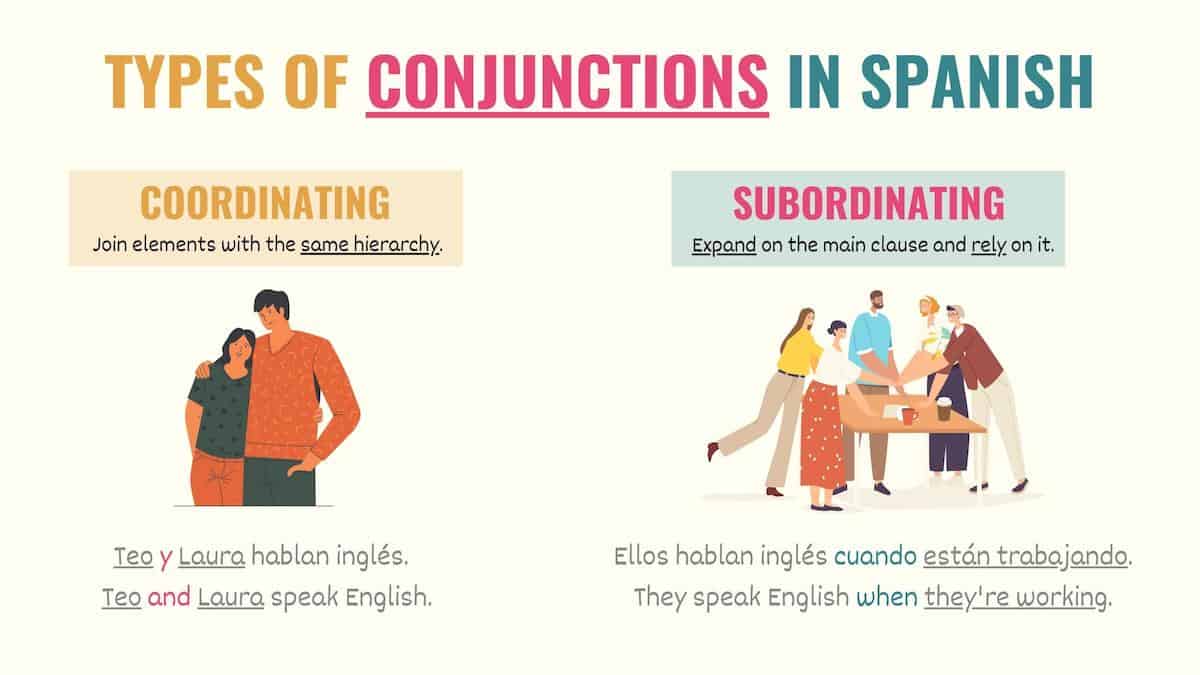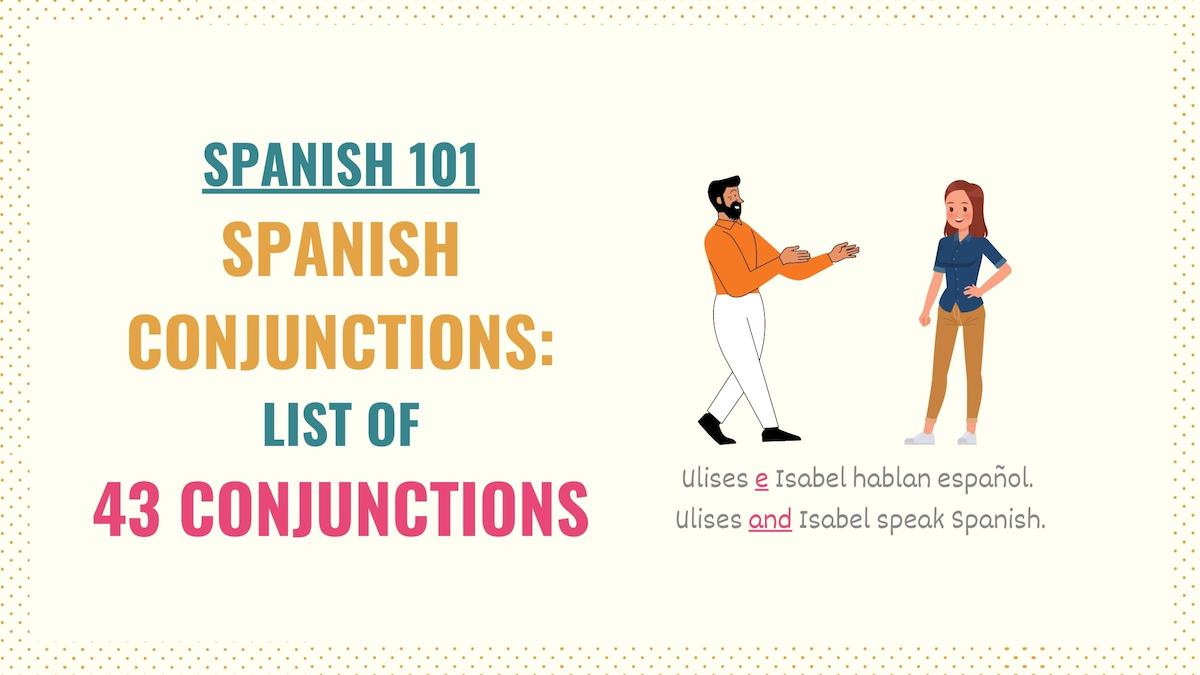Spanish conjunctions are critical when forming sentences because they allow you to connect words and ideas while maintaining the communication flow. Simply put, conjunctions in Spanish are the words that prevent you from creating multiple choppy short sentences.
Given their importance when learning Spanish, this guide will teach you everything you need to know about conjunctions. Here is a quick overview of what we’ll cover:
- What Are Spanish Conjunctions
- Coordinating Conjunctions in Spanish
- Spanish Subordinating Conjunctions
- Difference Between Prepositions & Conjunctions
- Key Points
- Downloadable PDF
Take Note: Conjunctions are one of the nine parts of speech in Spanish grammar. In short, they’re a fundamental type of word you must learn to form sentences correctly.
What Are Spanish Conjunctions?
Spanish conjunctions are terms that join words or clauses together, so they read as one sentence. For example:
Beto, Paco y yo fuimos al cine.
Beto, Paco, and I went to the movies.
Ven tan pronto como puedas.
Come as soon as you can.
Check the examples above one more time.
Spanish conjunctions always join elements that belong to the same type of word or are performing the same function (like pronouns). Simply put, they join verbs with verbs, adjectives with adjectives, and so on.
A conjunction in Spanish can also be a single word, such as y. Or they could be compound, which means that you form them with more than one word, such as tan pronto como.
Whether they’re a word or a short phrase, conjunctions never change to mark gender nor do they have a plural form.
Depending on the type of relationship they’re creating, Spanish conjunctions can be classified into:
- Coordinating conjunctions
- Subordinating conjunctions

You’ll learn more about these types of conjunctions in the sections below.
Take Note: Because they join elements together, conjunctions and Spanish transition words (sometimes called connectors) are usually confused. Conjunctions join elements in the same sentence, while connectors can be used between two separate sentences.
List of Spanish Coordinating Conjunctions
Coordinating conjunctions in Spanish link words with the same sentence hierarchy. This means that the elements you’re linking have equal value. Because they don’t depend on each other, they could stand alone in the sentence.
Below are the subcategories of Spanish coordinating conjunctions, along with some examples.
Copulative conjunctions
Spanish copulative conjunctions allow you to add more elements in a sentence. Examples of these conjunctions are:
- Además de – Besides / In addition to
- Así como – And / Just as
- Así como también – As well as
- Así como tampoco – Nor
- Ni – Nor / Not even
- Tan…como – Both…and
- Tanto…como – Both…and
- Y (e) – And
- Y también – And also
Ulises e Isabel hablan español.
Ulises and Isabel speak Spanish.
No sé ni quiero saber.
I don’t know, nor do I want to know.
Betty es tan linda como amable.
Betty is both cute and nice.
Y is one of the most common conjunctions in Spanish. However, we must replace it with the vowel e if the word we’re adding starts with an ‘i’ sound. Check this article on y vs e to learn more about these pronunciation rules.
Take Note: Some compound conjunctions may work with adjectives or adverbs. When it comes to adjectives, you must make sure to make the word plural or mark the gender accordingly.
Disjunctive conjunctions
As its name suggests, disjunctive conjunctions in Spanish join elements while presenting an alternative. Some examples of these words include:
- O – Or
- U – Or
- O…o – Either…or
Puedo ir hoy o mañana.
I can go today or tomorrow.
Habla con Carlos u Osvaldo.
Talk to Carlos or Osvaldo.
Adversative conjunctions
Spanish adversative conjunctions express a contrasting idea between the elements they’re linking. For example:
- Aunque – Even if / Although
- Mas – But
- Pero – But
- Sin embargo – However / But
- Sino – But / But rather
Quiero ir, pero no puedo.
I want to go, but I can’t.
La película es buena, aunque es un poco larga.
The movie is good, although it’s a bit long.
List of Subordinating Conjunctions in Spanish
Spanish subordinating conjunctions are used to expand or further describe a main independent clause. In other words, these conjunctions connect a main sentence with a subordinate clause (also called dependent clause).
Subordinating conjugations in Spanish can express cause, condition, time, comparison, and purpose. Be aware that these types of conjunctions can fall into more than one of these categories.
Here are some examples of the most common subordinating conjunctions in Spanish:
- A fin de que – In order to / So that
- Antes que – Before
- Aun cuando – Even when
- Cada vez que – Every time / Whenever
- Conque – So / So then
- Con tal de que – As long as / Providing
- Como si – As if / As though
- Cuando – When / Even when
- Justo cuando – Just when / Just as
- Menos que – Less than
- Mientras – While
- Para que – So that
- Porque – Because
- Por más que – No matter how much / Although
- Por mucho que – No matter how much / Even though
- Pues – Since / As / Because
- Puesto que – Because / Given that
- Que – That / Than / Because
- Según – Depending on / Just as
- Si – If / Whether
- Si no – If not
- Si acaso – In case / Just in case
- Siempre que – Every time / Provided that
- Siempre y cuando – Provided / As long as
- Tal como – Just as / As
- Ya que – For / Because / Since
And here are some examples of how to use these words:
No quiero ir si tú no vas.
I don’t want to go if you don’t go.
Me siento mal cada vez que peleamos.
I feel bad every time we fight.
Sasha está enojada porque no la ayudamos.
Sasha is mad because we didn’t help her.
¿Por qué haces eso cuando sabes que me molesta?
Why do you do that even when you know it bothers me?
Take Note: Subordinate clauses are sentences that depend on a main clause. In other words, they cannot stand alone because they don’t have full meaning on their own.
Prepositions vs Conjunctions In Spanish
Spanish prepositions are words that link nouns, pronouns, verbs, and complements while indicating origin, destination, direction, location, or cause. On the other hand, conjunctions can join two sentences and they imply different types of connection (such as adding information).
Check the following examples:
Las llaves están en la mesa.
The keys are on the table.
El celular y la cartera son para ella.
The phone and the wallet are for her.
No quiero ir, pero tengo que hacerlo.
I don’t want to go, but I have to.
Key Points
Since they’re used to connect terms and clauses together, Spanish conjunctions are key to forming coherent and fluent sentences. Here are some key points you should know:
- Conjunctions in Spanish can be single words (y, pero, o) or compound if they’re formed with more than one term (siempre y cuando).
- There are two main types of conjunctions in Spanish – coordinating and subordinate conjunctions.
- Spanish coordinating conjunctions join elements with the same value in the sentence (nouns with nouns/pronouns, verbs with verbs, etc).
- Coordinating conjunctions can add and contrast information or provide alternatives. Examples of coordinating conjugations are y, o, pero.
- Spanish subordinate conjunctions join a main clause with a dependent or subordinate sentence.
- Subordinate conjunctions provide more information about the main clause. This information can be conditions, time, cause, purpose, or comparisons.
Conjunctions are very common in our conversations. So, don’t hesitate to start using them! ¡Buena suerte!
Download the Conjunctions in Spanish PDF Cheat Sheets
With all the various types of conjunctions and rules to using them, some Spanish learners might need a refresher on the learning materials now and again. That’s why I’ve created a free PDF containing the highlights, vocabulary, phrases, charts, list of conjunctions, and key points for this guide.



